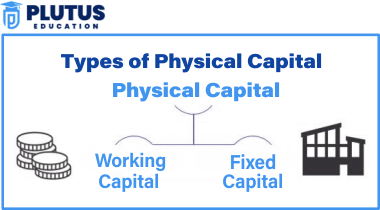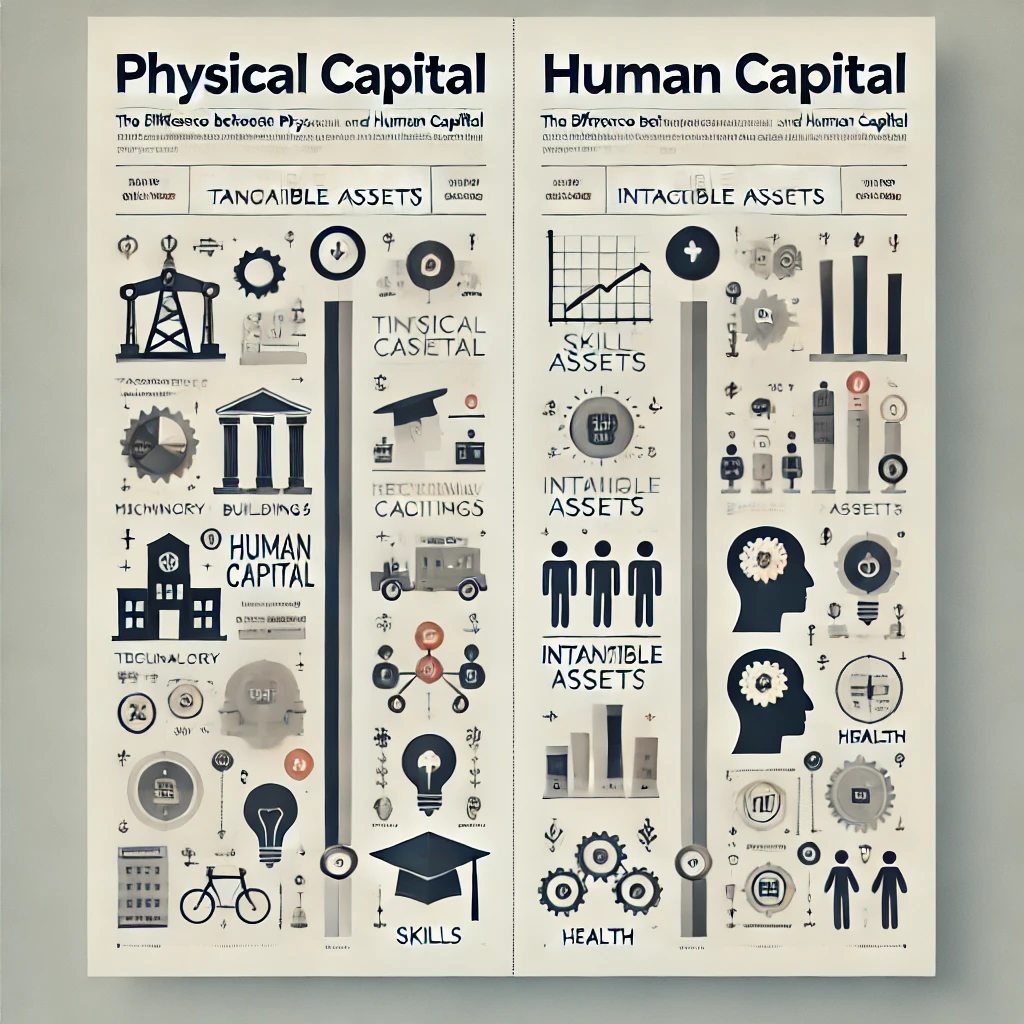Physical capital and human capital: are two kinds of resources associated with economic and business concepts, which are perceived to greatly contribute to productivity and economic growth. The paper, for purposes of discussion seeks to analyze how the distinction between these two kinds of resources may be important for developing their impact at various levels of microeconomics and macroeconomics.
Physical capital and human capital are relatively acceptable terms that go hand in hand with other factors leading to economic development and productivity in organizations. The physical capital refers to the tangible assets such as machinery, buildings, and tools that help in the production process, while the human capital refers to the skills, knowledge, or abilities of individuals that enhance their productivity. Any business or economy needs both kinds of capital, but they differ significantly as regards their nature, formation, and resultant impact on growth.
What is Physical Capital?
All the physical assets through which a business or economy is able to produce goods and services come within physical capital. This would relate directly to machinery, equipment, buildings, vehicles, and infrastructure, as well as technology and various tools that facilitate the production process.
Features of Physical Capital
- Tangible Nature: Physical capital is always tangible, meaning it has a physical form that can be touched, seen, and quantified. This includes assets like machines, factories, computers, and other equipment.
- Depreciation: Over time, physical capital depreciates due to wear and tear, aging, or technological obsolescence. Regular maintenance and upgrades are required to keep these assets productive.
- Investment Requirement: Building physical capital requires a substantial investment in money, resources, and technology. This investment is crucial for businesses looking to enhance their production capacity.
- Measurable: The value of physical capital can be easily quantified in monetary terms, making it easier to assess its worth on a balance sheet or during financial evaluations.
Types of Physical Capital
- Fixed Capital: These are long-lived assets, such as machinery and factories, buildings, and any other equipment that is not changed frequently.
- Working Capital: Those assets that have to do with day-to-day operations and in which the business operates, such as raw materials, inventory, and consumable supplies.

What is Human Capital?
Human capital consists of the skills, knowledge, abilities, and experiences acquired by individuals through education, training, or experience, an intangible asset that improves the productivity of individuals and the overall efficiency of an organization.
Features of Human Capital
- Intangible Nature: Human capital is nontangible in nature because it exists in terms of knowledge, skills, education, and mental abilities.
- Non-depreciable: Human capital does not depreciate like it is the case for most of physical capital. It will grow over time as a result of continuous learning, training, and experience accumulation.
- High Mobility: Human capital is highly mobile and transferable. Skilled people can easily shift from one organization to the other while carrying along their learned and acquired abilities with them.
- Investment in Education and Training: Human capital requires investment in education, professional development, and skill enhancement programs to increase the productivity of the manpower.
Types of Human Capital
- General Human Capital: Skills and knowledge that can be applied across different jobs or industries, such as communication, leadership, and problem-solving skills.
- Specific Human Capital: Specialized knowledge or expertise that is relevant to a particular job, task, or industry, like medical skills for doctors or programming knowledge for software developers.

Physical Capital vs. Human Capital: Key Difference
| Aspect | Physical Capital | Human Capital |
|---|---|---|
| Definition | Tangible assets used in the production process. | Skills, knowledge, and abilities of individuals. |
| Nature | Tangible and measurable. | Intangible and non-measurable. |
| Depreciation | Subject to depreciation over time. | Does not depreciate but can become obsolete. |
| Investment | Requires monetary investment to acquire. | Requires investment in education and training. |
| Mobility | Less mobile, fixed to a location or operation. | Highly mobile, can transfer from one job to another. |
| Role in Production | Enhances productivity through tools and machines. | Enhances productivity through improved skills. |
Conclusion
Both physical and human capital are essential elements for the economic development and growth of any organization or country. Physical capital is tangible, therefore, contributing to the increase in production efficiency. Human capital, however, is related to skills, knowledge, and competencies that will increase the capability of the workforce. Investment in these two kinds of capital would be critical for sustainable growth and competitiveness within the modern economy.
Difference Between Physical Capital and Human Capital FAQs
What is the main difference between physical capital and human capital?
Physical capital consists of tangible assets like machinery and equipment, while human capital involves the skills and knowledge of individuals.
Can human capital depreciate like physical capital?
Human capital does not depreciate in a traditional sense but can become obsolete if individuals do not upgrade their skills or knowledge.
Why is investing in human capital important?
Investing in human capital through education and training increases productivity, innovation, and the overall competitiveness of an organization.
How do businesses acquire physical capital?
Physical capital is acquired through investments in machinery, equipment, technology, and infrastructure required for production.
What role does human capital play in economic development?
Human capital plays a vital role in innovation, productivity, and economic growth by enhancing the skills and abilities of the workforce.


